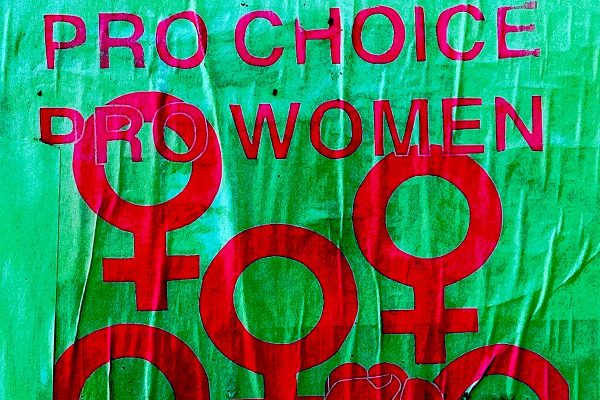“Texas has compelling interests from the outset of a woman’s pregnancy in protecting the health of the woman and the life of the unborn child,” reads SB8, the state’s near total abortion ban, which went into effect September 1 when the Supreme Court declined to enjoin it. On October 7, in response to an emergency request from the U.S. Department of Justice, a federal judge blocked the law. “Women have been unlawfully prevented from exercising control over their lives in ways that are protected by the Constitution,” wrote U.S. District Court Judge Robert Pitman.
In a 113-page ruling, Pitman firmly put the lie to SB8’s justification, reiterating the proven safeness of abortion and reprising the state’s long history of legislation undermining women’s health by crippling providers’ ability to perform abortions in a medically sound and timely way. “Other courts may find a way to avoid [the] conclusion” he reached, noted Pitman. He was likely alluding to the Supreme Court, which on December 1 will review a Mississippi statute banning abortion at fifteen weeks, which directly challenges Roe v. Wade. The decision is widely understood to indicate the conservative majority’s willingness to severely weaken Roe or even overturn it.
But whatever SCOTUS does, the anti-abortion movement will not be stopped. It will carry on as before, powered by the same morally and politically muscular message that SB8 communicates: The government cares about what happens to women’s bodies. And when Texas deputizes the masses to enforce its ban through civil lawsuits, it is not just slithering out of judicial scrutiny (a strategy Pitman also excoriates). Nor is it simply doing what red states do—privatize government. SB8 tells the world that pregnancy and birth are not only the state’s business. They are everybody’s business.
The antis, in other words, uphold a compelling public interest—a collective moral obligation—in eradicating abortion. It takes a village to gestate a child.
Feminists fight for pregnant people’s and fetuses’ health too—for universal, affordable, accessible reproductive healthcare. But we have not boldly made an opposite, equally powerful case: The right and ability to terminate a pregnancy safely and without cost, bias, or stigma is a guarantor (if not the only one) of the existential equality and human flourishing of all uterus-bearing people.
States have a compelling interest—a profound obligation—to defend the right to abortion. Abortion is a public good.
Why haven’t we linked abortion to the commonweal?
The answer lies in Roe v. Wade and in a strategy, conceived and led by a liberal, largely white advocacy community, that depends on Roe to protect abortion and therefore makes the defense of Roe its premier organizing goal. To elevate Roe in this way is to accept a compromise as the sine qua non of a movement: reform of abortion laws rather than their total repeal. It is also to hew to a legal logic that begins with a constitutional right to privacy. From privacy follows “choice,” an individual act implying freedom unfettered by structural impediments such as poverty or race. But the private abortion decision Roe safeguarded in 1973 is also a fantasy, for it occurs in a context foreign to many Americans then and to almost all today: a stable, affordable doctor-patient relationship.
With this strategy, a struggle for freedom from laws devolved into a legal sub-specialty. A cause allied with the women’s self-help health movement and the demedicalization of pregnancy and birth became a dependent of the healthcare profession. A movement with roots in the left was captured by the neoliberal myth of individual self-determination. Inside this narrow conceptual corridor, the opposition could pick off bits of the right to abortion one by one, like shooting targets at a firing range. Privacy promised autonomy, but as the space for “choice” contracts, privacy leaves the pregnant person on her own.
A right resting on Roe dies with the death of Roe. In the short term this will be a catastrophe; in states like Mississippi, Oklahoma, Texas, and dozens of others, it already is one. But paradoxically, losing Roe might force us to rebuild a movement, one based on the assertion of reproductive rights and sexual freedom nested within a vision of broad social justice.
Privacy and choice
Like all of U.S. political, social, and economic culture, our Constitution enshrines individual liberty. Roe v. Wade is based on the apotheosis of individualism, privacy. In 1965, Griswold v. Connecticut established the right to “marital privacy” in the use of contraception. Eight years later, Roe extended the right to abortion. The right to privacy is not named in the Constitution but exists within the so-called “penumbra” of other enumerated rights, as protected by the Ninth Amendment.
But privacy was an equivocal, never absolute, right. “Appellant would discover [the right to abortion] in the concept of personal ‘liberty’ embodied in the Fourteenth Amendment’s Due Process Clause,” wrote Justice Harry Blackmun for the majority, “or in personal, marital, familial, and sexual privacy said to be protected by the Bill of Rights or its penumbras.” But, added Justice Byron White, the court was doubtful about “an unlimited right to do with one’s body as one pleases.” Indeed, precedent legitimated the regulation of abortion, its permissibility and medical delivery, to protect both the pregnant woman’s health and “the potentiality of human life.”
For the abortion rights movement, “Privacy (Limits May Apply)” was not a slogan to rouse the troops. In fact, even before Roe, activists recognized that Pro-Life had the rhetorical edge. In a 1972 memo Jimmye Kimmey, executive director of the Association for the Study of Abortion (ASA), proposed two alternatives, Right to Choose and Freedom of Conscience. Kimmey liked the former as catchier and more active, but also hoped someone would come up with something better than either. No one did. And as the right made abortion a dirty word, “choice” gained favor as a euphemism, not for its strength but for its softness.
There’s another reason “choice” stuck: It sounds like an advertisement for Burger King. Choice is a consumerist concept and a neoliberal myth. If you have no health insurance, if your wage doesn’t cover the rent, much less rearing a child from crib to college, if you live near a toxic waste dump that gives your kid asthma, you must have made some bad choices. And if you were casual about contraception or the condom broke—well, you made some really irresponsible choices. Suck it up.
The neoliberal myth that your fate is your choice and your troubles are your fault obscures history, economics, and social reality. It discourages collective action and mobilizes shame. Together privacy and shame cloak harm perpetrated by those with power, from sexual harassment in the workplace to child sexual abuse at home. Meanwhile, communities whose facial features are stored in police files and whose families are under constant surveillance by “protective” agencies have no illusion that their privacy ever existed. Privacy is a good thing—we do not want the government, or Facebook’s algorithmic bots, listening in on our breakfast table conversations or hiding under the bed when we’re having sex. But if privacy even exists in an economy that records every step and monetizes every keystroke, we should be aware of its limits: it is a bourgeois privilege.
Professionalization and paternalism
Just as a reliance on Roe turns a movement into a law firm, the ruling itself squeezes another profession into its sanctum of privacy. Relegating reproductive decisions to a “woman and her doctor,” Roe transformed a clamorous street demonstration into a waiting room full of patients. What could have been a blow to the patriarchy became a boon for paternalism. As if to underline the diminishment of the uterus-owner’s power, the ACLU’s website adds a third party to the doctor-patient confab: the family. Parental consent was the first battle we lost, in 1976. Do husbands have a vote again too?
When Roe was heard, it had been a century since a burgeoning medical profession wrested pregnancy and childbirth from the hands of midwives, doulas, and female healers. “We are the physical guardians of women,” read an 1859 report on “criminal abortion” from the American Medical Association, founded just two years earlier. “The case is here of life or death—and it depends, almost wholly, upon ourselves.” When the Comstock Laws criminalized abortion in 1873, they left an exception for physicians to perform “therapeutic” procedures, whose urgency they alone determined. In 1974, doctors’ testimony on grave injuries and death from back-alley abortions was critical to the ruling in Roe, and the profession was not about to yield authority—or clientele—when the practice was legalized.
Thanks to the Hyde Amendment, which has restricted Medicaid payments for abortion since 1977, to hundreds of costly, harassing state regulations and providers’ commitment to keeping prices down, it is hard to make money running an abortion clinic. Yet abortion remains the kept wife of medicine. An unintended consequence is that clinicians have been left to hold the fort and—literally—take the bullets. Dependence on the medical profession has distorting effects on both care and activism.
As smaller clinics fall, in many places Planned Parenthood is the last provider standing, an efficient set-up for maximum damage from the right. A faked exposé of PP’s alleged traffic in human body parts lit a conflagration that singed all abortion advocates’ reputations. Trump Administration amendments to Title X and Medicaid forced the organization to forgo federal funding in order to keep doing abortions, affecting 1.5 million low-income patients, who are also disproportionately of color.
Planned Parenthood also maintains an outsized voice in abortion politics. For instance, its current campaign, focused on Texas and five other states, is “Bans Off Our Bodies.” Apparently it did not occur to anyone in Washington that the slogan does not translate into Spanish (El Paso, a border city, is not using it). And then there’s the trivializing, unfunny, and white-vernacular acronym BOOB.
A renewed movement: Rights and justice
“Choice” makes pregnant people consumers. The dominance of professionals makes them clients. Privacy locks them in a room with a doctor and their family. Abortion is rendered increasingly apolitical.
For some, the less political, the better. This isn’t just to avoid uncomfortable controversies. Trepidation and disgust are understandable responses to the suggestion that abortion is more a collective concern, or subject to the public scrutiny that might win its place as a public good.
Such scrutiny sounds dangerously like state interference, and the history of state interference in fertility is pernicious, from nationalist motherhood campaigns to forced sterilization in the name of eugenics and population control, smuggled in under the aegis of public health. In the U.S. today, the compelling interest of the state and public institutions in protecting the unborn child, redefined as a legal person, is exercised in child abuse prosecutions against drug-using or otherwise “unfit” pregnant people who have miscarriages or abortions; these and others represented by the National Advocates for Pregnant Women may be forced to undergo drug treatment or unnecessary cesarean sections, and often, finally, to lose custody of their babies. Not surprisingly, the targets of this intrauterine War on Drugs are overwhelmingly Black, brown, and poor; many are among the most marginalized. SB8 will also disproportionately affect Texans of color, who make up two-thirds of the state’s abortion patients.
How do we reconcile bodily autonomy with the collective good? This is not an abstract question. It is a strategic one central to rebuilding our movement, whether or not Roe is overturned. Here are a few ideas for rejoining the fight to control our reproductive lives while joining that fight to a broader struggle for social justice.
- Replace privacy with bodily autonomy. Understand the policing of abortion as a chapter in the racist history of the carceral state.
- Link abortion and bodily autonomy to sexual freedom.
- Replace choice with universal access to reproductive health care. Reject medical paternalism while holding the state responsible for public health and robust support for parents and children.
- Adopt the framework of reproductive justice. Recognize reproductive justice as intrinsic to democracy, economic security, equity, and peace.
Bodily autonomy, not privacy
The Roe court distinguished privacy from liberty and argued that the former is consistent with regulation. But in doing so, Justice White cited two cases in which privacy was not just tempered by regulation but trumped by compulsion: Jacobson v. Massachusetts (1905), which upheld the constitutionality of vaccination requirements; and Buck v. Bell (1927), which authorized on eugenic grounds the involuntary sterilization of a “feeble-minded” woman institutionalized in Virginia, whose mother and child were also “feeble-minded.” Privacy did not save Carrie Buck.
In fact, the Constitution limits liberty too: the Thirteenth Amendment bans slavery and involuntary servitude, “except as a punishment for crime.” As Ava Duverney’s film Thirteen demonstrates, the involuntary servitude of formerly enslaved people has slipped through this loophole long after emancipation—from their arrests and impressment onto chain gangs or prison farms under Jim Crow to their mass incarceration today, in prisons where inmates work for pennies per hour.
The denial of a desired abortion is not tantamount to slavery. Access to abortion is not the same as freedom from bondage. Indeed, some activists of color object to the use of “underground railroad” to describe networks helping people travel out of anti-abortion state to terminate pregnancies.
Nevertheless, gestating a fetus in one’s body for nine months and giving it birth is hard reproductive labor. Doing this against one’s will is a grievous violation of bodily autonomy. And the vigilante justice enforcing that compelled labor in Texas has a place in a history going back to slavery times.
In 1846 the state of Texas established court-appointed slave patrols, whose assignment was to hunt down enslaved people of African descent “strolling about” without written permission and to mete out punishment by the lash. In 1848, other state laws allowed the “patty-rollers” to seize white people who helped runaways. Reinforced by freelance slave-hunters, the patrols were Texas’s first organized state-funded law enforcement, almost three decades before the Texas Rangers.
Bounties offered by slaveholders and sheriffs were part of the regulation of U.S. slavery-based capitalism; the Fugitive Slave Act of 1850 federalized the whole thing, inviting Northern gangs like New York’s “kidnapping club” to join the trafficking of both formerly enslaved and born-free people of African descent, including children. Historians call the slave patrols, which date back to the eighteenth century, the original U.S. police departments.
Texas law creates a profit motive for a largely white mercenary army to compel disobedient bodies to perform unpaid labor. If the Supreme Court overturns Roe, as it might well do, the citizen brigades will remain useful to the carceral state, joining informants from Karens to prison snitches.
The carceral state imperils the lives of certain people—Black and brown, poor, homeless, mentally ill, gender nonconforming, or sexually “deviant”—to protect an unspecified, selective “public safety.” That selected public now includes the “unborn.” In positing a state interest in potential life, Roe opened the way to remodel gestation in the image of the adversarial legal system, wherein the fetus is an innocent victim and the uterus-bearer is the perpetrator, guilty of unprotected or unmarried sex, drug use, or abortion itself. Child abuse charges against people who have miscarriages and legalized harassment and impoverishment of providers, friends, and drivers to the clinic follow a carceral logic: To protect one is to punish another. One must be expendable for the other to be saved.
Overpoliced and under-resourced communities understand that individual health and security are critical to collective survival and mutual aid is critical to individual thriving. The struggle for compassionate, affordable, respectful reproductive services on demand and without conditions repudiates the policing of bodies and demands abundant resources, equitably distributed.
Sexual freedom
Before Roe the terror of unwanted pregnancy afflicted roughly half the population—the half who could get pregnant—with anxiety that clobbered pleasure; unwanted pregnancy forced teenagers and unwilling partners into marriage. Yet sex is not mentioned in Roe v. Wade except as irrelevant to the case. Along with Jane Roe, the pseudonymous John and Mary Doe also appealed the Texas law, claiming that the unavailability of abortion had a “detrimental effect upon [their] marital happiness” because they were forced “to the choice of refraining from normal sexual relations or of endangering Mrs. Doe’s health through a possible pregnancy,” according to the record. The court found their claim—she might get pregnant, it might harm her health, the prospect might interfere with their sex life—too speculative and denied them standing.
After dispatching the Does, the majority went on to dismiss some plaintiff’s argument that abortion laws have the not-so-covert goal of controlling women’s sexual lives. The Texas statute did not state this intent, the court said. Therefore sexual prohibition was not its intent. Once sex is tossed aside, the opinion proceeds to focus on woman’s physical and mental health, the state’s interest in potential life, and a framework of medical regulation.
Even though Roe is agnostic on a right to sexual privacy and its link to sexual liberty, the ruling added to a precedent that would both expand and circumscribe the decriminalization of sex. Lawrence v. Texas (2003) overturned a law criminalizing same-sex acts, ruling that “the liberty protected by the Constitution allows [adult] homosexual persons the right to choose to enter upon relationships in the confines of their homes and their own private lives.” Obergefell v. Hodges (2014) let same-sex lovers get married; relational privacy was one of the winning arguments.
But neither of these rulings freed teens to have consensual gay sex, or any consensual sex for that matter. Lawrence gave an approving nod to the prohibition of sex in public parks. In Obergefell the court listed four reasons why marriage is a “fundamental” right. Number four: It “is a keystone of the Nation’s social order.” Contrary to opponents’ fears, legalizing other-than-heterosexual intimate acts in private does not promote sex with children or animals, or the downfall of civilization.
Sexual freedom is a function of bodily autonomy. It must not be predicated on privacy or reserved for those whose genders, relationships, or desires are sanctioned by the state. But its absence is not an issue only for the marginalized.
Pleasure is as much a right as the right not to have children or to have them in a safe and loving environment. The option of abortion is essential to sexual happiness, and that is enough of a reason to defend it.
Access, not choice
According to the WHO, nearly half of all abortions globally are unsafe, and almost all of these unsafe abortions take place in developing countries. In the United States, poor women have unintended pregnancies and births at five times the rate of their higher-income peers. A 2009 study of over five million U.S. pregnancies found that “congenital anomalies” are more likely to account for the in-utero deaths of white fetuses than of Black; Black fetuses more commonly succumb to adverse—and remediable—conditions of pregnancy and labor, such as poor nutrition or inadequate prenatal care. Prematurity is linked to environmental hazards, including high lead levels and air pollution where the poor and people of color live and work.
Infant mortality is more than twice as high among Black infants as white. Black women die in childbirth at a rate three to four times their white counterparts. Largely to blame are the same disparities in health and health care that the COVID-19 pandemic brought to glaring light. But even middle-class, educated Black women suffer disproportionate rates of low birthweight babies and infant death. One cause is “weathering”—the physical effects of living under systemic racism. That racism is evident among health care providers, too, who undertreat Black patients’ pain and dismiss their symptoms. Serena Williams, one of the wealthiest women in the world, had trouble convincing her doctor that she was having a pulmonary embolism after giving birth to her daughter. She nearly died.
Just as communities can be safe—safer—without police, pregnancy and birth can be healthier and less stressful without doctors. But the rejection of medical paternalism—whether that’s making an exception for a Texan abortion patient after six weeks or sterilizing inmates in a California prison—does not exempt government from its obligations to provide universal, accessible, high-quality health care, along with decent housing, a clean environment, and social and economic supports for families. Choice is a neoliberal fiction. If you can’t get it, you can’t choose it.
Reproductive justice and human rights
Reproductive rights are individual. Justice is social. At their intersection is reproductive justice. As defined by the SisterSong Women of Color Collective, reproductive justice is “the human right to maintain personal bodily autonomy, have children, not have children, and parent the children we have in safe and sustainable communities.” In the same spirit, the October 2 demonstrations, organized by Women’s March in coalition with dozens of groups, from Catholics for Choice to the Trans Empowerment Project, raised the banner of Abortion Justice. The slogan embodies the interdependence of the two, each empowering the other.
The struggle for social justice extends far beyond the pursuit of legally recognized civil rights. Asked in a webinar how to keep the fight alive when the action feels far away, in the courts, veteran activist Loretta Ross—one of the twelve women of color who conceived the idea of reproductive justice in 1994—said: “The real site of struggle is in the community,” not in court. “The law is only as good as the people make it be.”
A feminist abortion justice movement that replaces privacy with bodily autonomy makes common cause with anti-carceral and anti-racist movements, as well as labor struggles for safe working conditions. A movement that replaces choice with the demand for universal health care is allied with the fight for climate justice and a caring economy; a movement embracing sexual freedom champions the sexual rights of youth and people with disabilities, the decriminalization of sex work, and the freedom from police harassment of queer and trans people, kink communities, and other sexual “outsiders.” A transformative reproductive justice movement celebrates pleasure.
The universal enjoyment of the human rights to reproductive and sexual health and agency is correlated with economic opportunity, democracy, and peace. By contrast, misogyny and discrimination against women are linked with a state’s militarism, internal violence, corruption, and economic stagnation. The achievement of racial, economic, gender, and sexual justice require safe, legal abortion. Abortion is a global public good.








